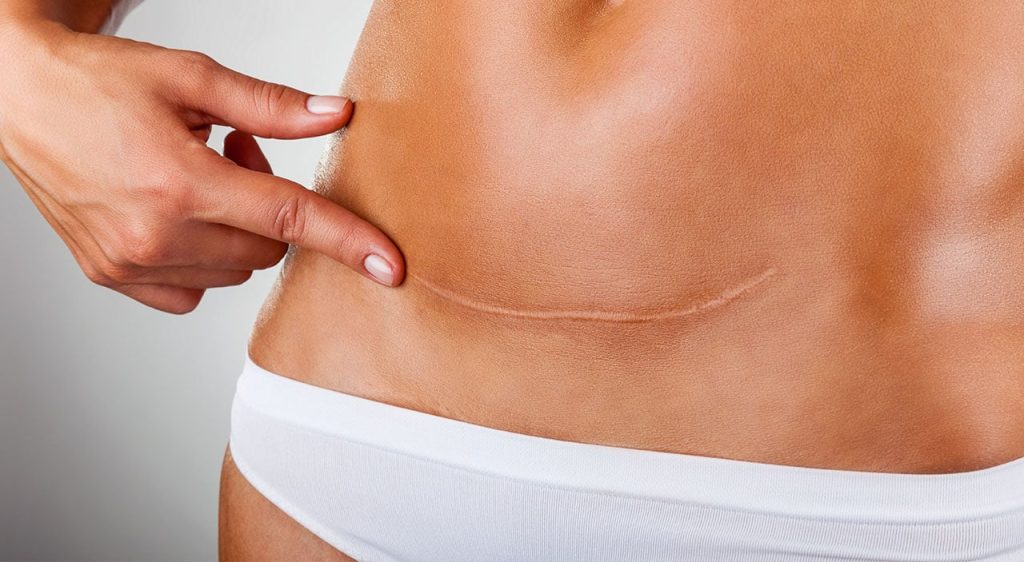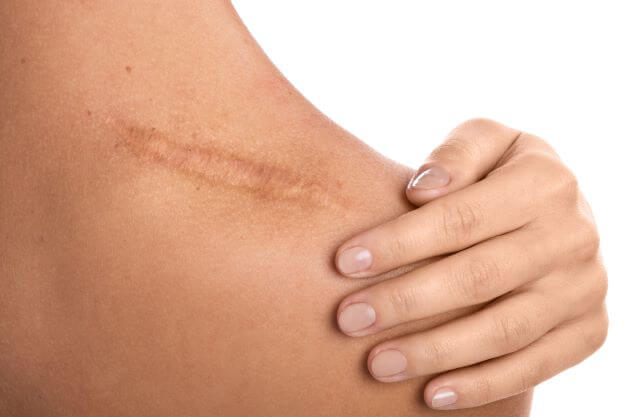Understanding Scar Types and Treatments
Keloid Scars
Keloid scars stand out due to their raised, dark appearance. They often extend beyond the original injury site. These scars, often addressed with plastic surgery, peels, or other surgical treatments requiring stitches, can be challenging to treat because they might return after removal.
Effective treatments include laser therapy and steroid injections. Both aim to flatten and lighten the scar.
Hypertrophic Scars
Hypertrophic scars are similar to keloids but don’t grow beyond the injury site. They are red and raised, making them somewhat easier to treat.
Options like silicone sheets, light therapy, and injections help reduce their prominence, but cost and insurers’ codes may affect accessibility. Laser therapy can also improve their texture and color.
Atrophic Scars
Atrophic scars create sunken areas on the skin, often resulting from acne or chickenpox. These indents make the skin appear uneven.
Treatments such as dermal fillers or laser resurfacing can help. They work by restoring volume or smoothing the skin’s surface.
Treatment Options
Various treatment options exist for scar removal. Surgical removal is an option for severe cases but comes with risks of new scars. Injections can reduce scar tissue, improving appearance without surgery.
Laser therapy is popular for its precision and minimal downtime. It’s effective for many scar types, enhancing skin texture and color.
Consulting a professional is crucial before choosing a treatment. They can recommend the best option based on your scar type and health.
Importance of Scar Revision for Aesthetics
Self-Esteem Boost
Scar revision through plastic surgery can significantly enhance one’s appearance. This improvement often leads to a boost in self-esteem. Individuals feel more confident in their skin after the procedure.
Many report feeling liberated from the constant reminder of past trauma or accidents. They embrace their new look with open arms.
Social Confidence
Visible scars can impact social interactions negatively. They sometimes become a source of discomfort or self-consciousness during conversations.
Undergoing scar revision can change this dynamic completely. It allows individuals to interact more freely and confidently, without worrying about their scars being a focal point.
Success Stories
There are countless success stories of people who have undergone scar revision surgery. These stories highlight not just the physical transformation but also the psychological upliftment experienced.
One individual shared how plastic surgery erased the scars from a severe burn incident, dramatically improving his social life and career opportunities. Another spoke of how scar revision helped her overcome years of bullying, leading to a remarkable increase in confidence.
Insurance Coverage Criteria for Scar Surgery
Medical Necessity
Insurers require proof of medical necessity for scar revision surgery. This includes documentation showing that the scar results from an injury or affects the person’s functionality. Health plans often demand a detailed letter from a healthcare provider. It should explain how the scar impairs physical functions or causes significant discomfort.
Patients must submit medical records and photos of the scar. They highlight its impact on daily life. Without this evidence, insurance companies may deny coverage, labeling the procedure as cosmetic.
Documentation Importance
Documentation is crucial for insurance approval. Insurers scrutinize medical records and letters from doctors closely. These documents must articulate why scar removal is more than just an aesthetic choice.
A well-documented case can make a significant difference. It increases the chances of getting scar surgery covered by insurance. Patients should ensure their healthcare providers detail every way the scar affects them physically and mentally.
Common Misunderstandings
Many believe all scars qualify for insurance-covered revision surgery. This is not true. Health plans typically cover scars that are hypertrophic, restrict movement, or result from surgical procedures.
Scars merely deemed unsightly without affecting function are less likely to receive approval for coverage. Understanding these distinctions can save patients time and frustration when seeking insurance support for scar treatment.
Scar Revision Surgery Costs Explained
Cost Range
Scar revision surgery costs can vary widely. They often range from $500 to several thousand dollars. This depends on the complexity and type of scar being treated.
Most minor procedures might only cost a few hundred dollars. In contrast, more complex surgeries can climb into the thousands. It’s crucial for patients to get a detailed quote from their surgeon.

Influencing Factors
Several factors influence the cost of scar revision surgery. The type of procedure is a major factor. Simple topical treatments are less expensive than surgical revisions.
The surgeon’s fees also play a significant role. More experienced surgeons may charge higher rates. Lastly, the location of the clinic can affect the price. Clinics in larger cities often have higher costs.
Financial Considerations
Patients should consider all financial aspects before proceeding with scar revision surgery. This includes potential insurance coverage and out-of-pocket expenses.
Insurance may cover some procedures if deemed medically necessary, as discussed in the previous section on “Insurance Coverage Criteria for Scar Surgery“. However, many cosmetic procedures are not covered by insurance, leading to higher out-of-pocket costs for patients.
Alternatives to Insured Scar Revision
Silicone Treatments
Silicone sheets and gels stand out as cost-effective alternatives for managing scars. They work by hydrating the scar tissue, which can reduce its size and coloration over time. People often use them for several months to see noticeable results.
These silicone-based treatments are easily accessible and do not require a prescription. This makes them a convenient first step in scar management.
Steroid Injections
Steroid injections offer another non-surgical option for scar treatment. They help by reducing inflammation, which can make scars less noticeable.
Doctors typically recommend them for raised scars, like keloids or hypertrophic scars. Patients may need multiple treatments to achieve desired outcomes.
Over-the-Counter Products
A wide range of over-the-counter products exists for scar care. These include creams and ointments that contain ingredients like vitamin E, onion extract, and hydroquinone.
While these products are readily available, their effectiveness varies from person to person. It’s important to have realistic expectations about the results they can deliver.
Natural Remedies
e people turn to natural remedies like aloe vera, honey, and essential oils for scar treatment. These options are generally safe but should be used with caution.
Before trying any natural remedy, it’s best to consult with a healthcare provider. They can offer guidance on safe and effective use.
Recovery and Aftercare Post-Scar Surgery
Recovery Timelines
Patients often wonder about the healing process after scar revision surgery. It varies depending on the procedure’s complexity and the individual’s health. Minor treatments might require only a few days of downtime, while more extensive surgical interventions could necessitate weeks for full recovery. During this period, experiencing some swelling, discomfort, and redness around the treated area is common.
Post-operative care is crucial for successful healing. Patients must follow their surgeon’s instructions closely, including how to manage dressings and when it’s safe to resume daily activities. These guidelines help minimize complications and ensure optimal healing.
Effective Aftercare
Adhering to a thorough aftercare regimen significantly impacts the surgery’s outcome. Key components include:
-
Wound care: Keeping the surgical site clean and properly dressed prevents infection and promotes healing.
-
Sun protection: UV exposure can worsen scarring. Patients should protect the area from direct sunlight by wearing protective clothing or applying high-SPF sunscreen.
-
Follow-up visits: Regular check-ups allow surgeons to monitor progress and address any concerns promptly.
These practices contribute to smoother recovery and better aesthetic results.
Importance of Instructions
The success of scar revision surgery largely depends on post-operative care. Following all medical advice regarding rest, medication management, and wound care is essential. Patients who diligently adhere to these instructions typically experience fewer complications and are more satisfied with their outcomes.
Preventing Scars Before They Form
Immediate Care
Proper wound management is crucial. Immediate cleaning and keeping the area moist play a vital role. Moisturizers can assist in this process, promoting new cells to grow. Bandaging also protects the wound from further injury.
Avoiding sun exposure is another key step. The sun can darken scars, making them more noticeable. Wearing protective clothing or using sunscreen on the area helps prevent this.
Avoid Picking
It’s tempting to pick at scabs, but it can worsen scarring. Scabs protect the healing process underneath. Letting them fall off naturally minimizes scar appearance.
Special Measures
People prone to keloids or hypertrophic scars need extra care. Using pressure garments or silicone pads can help. These methods apply gentle pressure and improve healing, reducing the risk of raised scars.
Initiating Your Scar Treatment Consultation
Consultation Prep
Before visiting a dermatologist or plastic surgeon, prepare thoroughly. Gather your medical history and any relevant documents about your scar’s development. This includes dates, treatments you’ve tried, and how the scar has affected you physically and emotionally.
Patients should also prepare a list of questions. Ask about the effectiveness of treatments like light therapy, potential side effects, and the number of sessions needed.
Setting Expectations
During your first visit, it’s crucial to set realistic expectations. Not all scars can be completely removed, but their appearance can often be significantly improved. Discuss with your healthcare provider what results are achievable for your specific case.
Understanding the limitations helps in making an informed decision. It aligns your expectations with likely outcomes.
Insurance Discussions
One key topic to discuss at the office is insurance coverage. Scar removal procedures may not always be covered by insurance, especially if deemed cosmetic. However, some cases related to health issues might get coverage.
Ask detailed questions about insurance policies and payment options available at their location. This conversation will give you a clearer picture of the financial commitment involved.
Summary
Navigating the world of scar removal surgery and its insurance coverage can be tricky, but understanding your options makes a big difference. You’ve learned about different scar types, the importance of aesthetics, what insurance typically covers, costs, alternatives to surgery, recovery tips, and how to prevent scars. Armed with this knowledge, you’re better equipped to make informed decisions about managing your scars. Remember, the goal is not just improvement in appearance but also a boost in confidence and quality of life.
Don’t let uncertainty hold you back from exploring scar treatment options. Reach out to professionals for a consultation to discuss your specific needs and concerns. They can provide personalized advice and help you navigate the insurance landscape. Taking action today could be your first step towards not only healing your scars but also reclaiming a sense of normalcy and well-being. Ready to start your journey? Contact a specialist now.
Frequently Asked Questions
Is scar removal surgery covered by insurance?
Scar removal surgery may be covered by insurance if it is deemed medically necessary. Criteria include impairing function or causing significant discomfort.
How much does scar revision surgery cost without insurance?
Costs vary widely based on the procedure’s complexity and location, but can range from several hundred to thousands of dollars.
What are some alternatives to insured scar revision?
Alternatives include over-the-counter treatments, laser therapy, and microdermabrasion. These options can be effective for less severe scars.
What should I expect during recovery from scar surgery?
Expect some downtime, with specific aftercare instructions to ensure optimal healing. Full recovery varies by individual and procedure type.
How can I prevent scars before they form?
Immediate proper wound care and avoiding sun exposure can significantly reduce the likelihood of prominent scarring.
How do I initiate a consultation for scar treatment?
Contact a qualified dermatologist or plastic surgeon who specializes in scar revision to discuss your options and potential insurance coverage.



